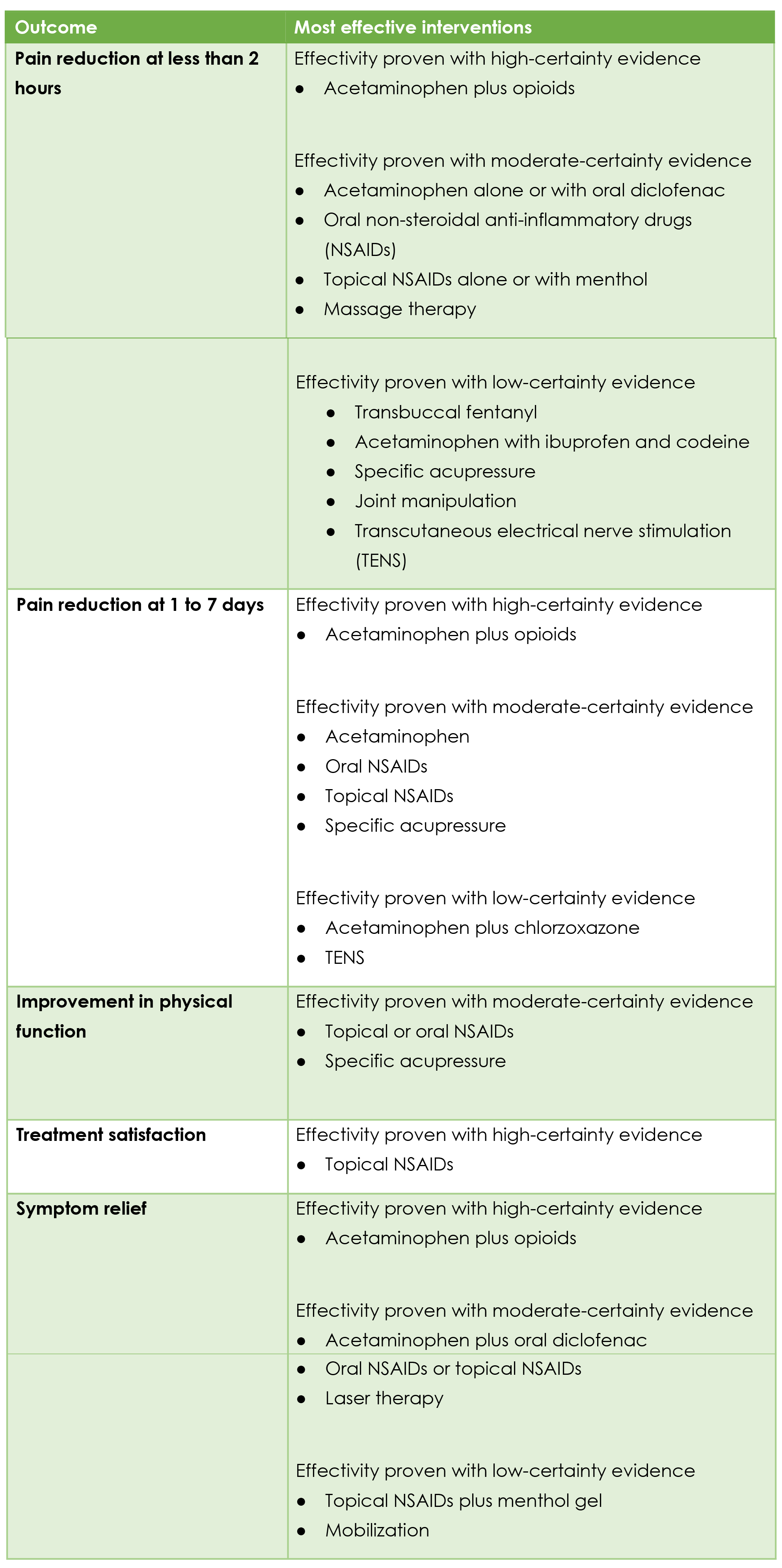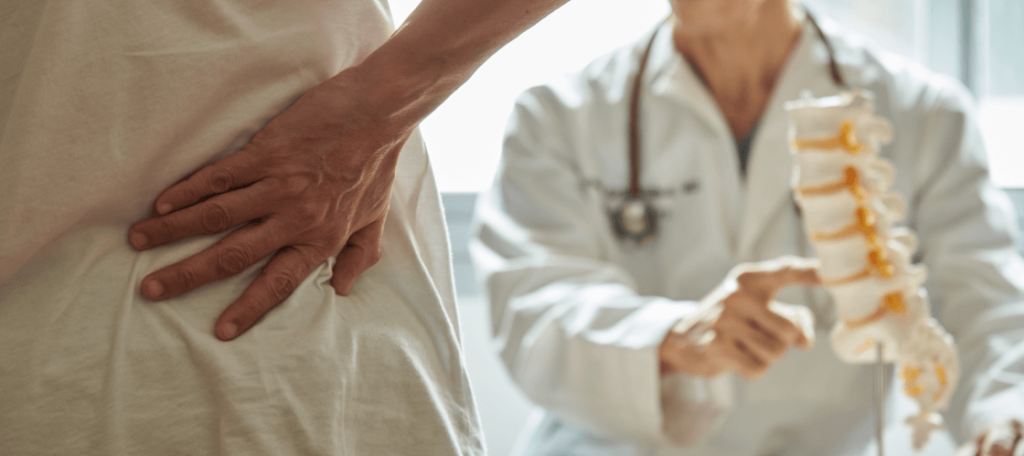Introduction
Musculoskeletal injuries are one of the most common grievances treated in outpatient settings, representing about 4 out of 5 injuries treated in a physician’s office. This category of injuries accounted for over 65 million healthcare visits in the United States in 2010. Acute musculoskeletal injury includes everything from strains, sprains, and soft tissue injuries, to whiplash, nonsurgical fractures, and contusions. In most cases such pain lasts for less than 4 weeks. The most common options for treating these injuries are either non-pharmacologic, or pharmacologic interventions which rely on non-opioid and opioid drugs. Pharmacologic treatment with opioids is quite common, but it raises serious concerns regarding the development of opioid abuse and dependence in patients. Therefore, a set of guidelines can help guide physicians in choosing an appropriate treatment alternative with minimal risk for patients suffering from intense pain related to musculoskeletal injuries.
About the Guidelines
The American College of Physicians (ACP) and the American Academy of Family Physicians (AAFP) jointly developed clinical guidelines that present recommendations on non-pharmacologic and pharmacologic treatment of acute pain from non–low back, musculoskeletal injuries in adults. The guidelines focus on pain management in the outpatient setting, since this is where such injuries are mostly treated.
The recommendations made in these guidelines focus on the benefits and harms for the available non-pharmacologic and pharmacologic treatments for musculoskeletal pain. These are taken into consideration in the context of costs as well as patient values and preferences. These guidelines are based on two systematic evidence reviews. One is a meta-analysis on the comparative efficacy and safety of non-pharmacologic and pharmacologic management of acute pain in musculoskeletal injuries in adults. The other is a review on the perils of prolonged opioid use. The meta-analysis included 207 controlled trials comprising of 32,959 patients with a median age of 34 years for the average patient. The reviewed studies cover different types of musculoskeletal injuries, including sprains, whiplash, ankle injuries, neck injuries, and injuries in the limbs and other locations, among others.
Main Outcomes Assessed
The following clinical outcomes were assessed during the evidence reviews:
- Pain (at ≤2 hours and at 1 to 7 days)
- Physical function
- Symptom relief (refers to either a marked response to the treatment or a complete resolution of symptoms, including absence of or full relief from pain)
- Treatment satisfaction (i.e., the patient’s overall feedback for the treatment).
- Adverse events (gastrointestinal, dermatologic, and neurologic)
Developing the Guidelines
The team used the GRADE (Grading of Recommendations Assessment, Development and Evaluation) methodology to create the guidelines. They first looked into the effectivity and benefits of non-pharmacologic and pharmacologic treatments for the identified main outcomes, as compared to placebo. This was followed by an assessment of the possible side-effects or harms of both types of treatments.
Summary of the Evidence
Beneficial Interventions
According to the evidence review, “the most effective” interventions were those that had significant benefits in comparison to a placebo and at least one other treatment. The following table gives a brief summary of these interventions for different outcomes.

Harms of Non-pharmacological and Pharmacological Interventions
The committee also reviewed the possible harms of the identified therapies, so as to make more balanced recommendations. Accordingly, the following table lists down the potential harms of the non-pharmacologic and pharmacologic interventions, including harms related to opioid usage.

Patient Values and Preferences on the Non-pharmacological and Pharmacological Interventions
Majority of the representative patient responses indicated a preference for topical NSAIDs or oral acetaminophen, followed by oral NSAIDs, specific acupressure, and TENS as the next most preferred therapies. None of the respondents preferred tramadol or transbuccal fentanyl. Some even indicated complete aversion to opioids considering how the harms outweigh the benefits.
Recommendations
Recommendation 1 (strong recommendation)
Patients should be treated with topical NSAIDs with or without menthol gel as a first-line therapy due to their efficacy in alleviating pain and other symptoms and improving physical function and patients’ treatment satisfaction with minimal risk to overall health.
Recommendation 2a (conditional recommendation)
Patients should be prescribed oral NSAIDs to improve all outcomes and symptoms including pain or oral acetaminophen for just pain relief.
Recommendation 2b (conditional recommendation)
Patients should receive specific acupressure to reduce pain and improve physical function or transcutaneous electrical nerve stimulation to alleviate pain.
Recommendation 3 (conditional recommendation)
Clinicians are discouraged from treating patients with opioids (including tramadol) given the evidence highlighting their severe harms and patient concerns regarding the same. These therapies should only be considered for cases with severe injury or intolerance to first-line therapies.
Conclusion
These recommendations are based on evidence indicating that the identified therapies are the most effective in improving either all or most of the preferred outcomes after musculoskeletal injuries, and are also not associated with increased risk of harm. However, concurrently the guidelines also caution clinicians to carefully asses all patient-specific risk factors before prescribing these interventions or alternatively prescribing the lowest effective dosage for the shortest period necessary.
Reference
- Qaseem A, McLean RM, O’Gurek D, Batur P, Lin K, Kansagara DL, Clinical Guidelines Committee of the American College of Physicians and the Commission on Health of the Public and Science of the American Academy of Family Physicians. Non-pharmacologic and Pharmacologic Management of Acute Pain From Non-Low Back, Musculoskeletal Injuries in Adults: A Clinical Guidelines From the American College of Physicians and American Academy of Family Physicians. Ann Intern Med. 2020 Nov 3;173(9):739-748. DOI: 10.7326/M19-3602. Epub 2020 Aug 18. PMID: 32805126
If you enjoyed reading this article, you may also appreciate our courses on Pain Medicine: Evaluation, Management and Treatment of Pain, which delve into similar subjects.
If you are interested in exploring more medical courses visit our newest product Docquity Academy. This platform empowers esteemed doctors from across Southeast Asia and beyond to disseminate their insights and knowledge through courses they’ve meticulously crafted. Discover more medical courses and join us in advancing your learning journey!
